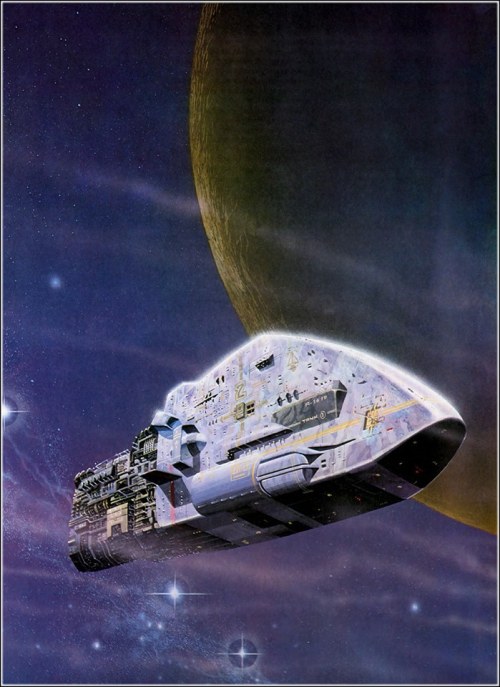John Berkey Cover Art For The Best Of Frederik Pohl, 1975.

John Berkey cover art for The Best of Frederik Pohl, 1975.
More Posts from Epic-flight and Others

Cesare Reggiani

Angus McKie

Rick Sternbach, 1976

March 16, 1966 – Astronaut Neil Armstrong in the Gemini 8 spacecraft, making final adjustments and checks during the prelaunch countdown. (NASA)

O_o When we peer deep into space, we don’t expect to find something staring back at us…
This galactic ghoul, captured by our Hubble Space Telescope, is actually a titanic head-on collision between two galaxies. Each “eye” is the bright core of a galaxy, one of which slammed into another. The outline of the face is a ring of young blue stars. Other clumps of new stars form a nose and mouth.
Although galaxy collisions are common most of them are not head-on smashups like this Arp-Madore system. Get spooked & find out what lies inside this ghostly apparition, here.
Make sure to follow us on Tumblr for your regular dose of space: http://nasa.tumblr.com

Every Point in Time.
Twitter / Instagram / Gumroad / Patreon
KnownOrigin / SuperRare / OBJKT / Zedge

Lynds Dark Nebula 1251 : Stars are forming in Lynds Dark Nebula (LDN) 1251. About 1,000 light-years away and drifting above the plane of our Milky Way galaxy, the dusty molecular cloud is part of a complex of dark nebulae mapped toward the Cepheus flare region. Across the spectrum, astronomical explorations of the obscuring interstellar clouds reveal energetic shocks and outflows associated with newborn stars, including the telltale reddish glow from scattered Herbig-Haro objects seen in this sharp image. Distant background galaxies also lurk on the scene, buried behind the dusty expanse. This alluring view imaged with a backyard telescope and broadband filters spans about two full moons on the sky, or 17 light-years at the estimated distance of LDN 1251. via NASA


Another oldie from my draft folder. I’d like to do a mass deletion of 99% of my unposted drafts.

Apollo 11 astronaut Neil Armstrong loads rocks into the lunar module, as painted by Apollo 12 moonwalker Alan Bean in 1985.
-
 tangledindream reblogged this · 4 months ago
tangledindream reblogged this · 4 months ago -
 tangledindream liked this · 5 months ago
tangledindream liked this · 5 months ago -
 catonthesun liked this · 1 year ago
catonthesun liked this · 1 year ago -
 inmystateofbuzz liked this · 2 years ago
inmystateofbuzz liked this · 2 years ago -
 wachsurfer2018 liked this · 4 years ago
wachsurfer2018 liked this · 4 years ago -
 yoxc liked this · 4 years ago
yoxc liked this · 4 years ago -
 epic-flight reblogged this · 4 years ago
epic-flight reblogged this · 4 years ago -
 strange-on3 liked this · 4 years ago
strange-on3 liked this · 4 years ago -
 metalzoic liked this · 4 years ago
metalzoic liked this · 4 years ago -
 takemetotheenterprise reblogged this · 5 years ago
takemetotheenterprise reblogged this · 5 years ago -
 ktm1290rtopbike liked this · 5 years ago
ktm1290rtopbike liked this · 5 years ago -
 stormbear reblogged this · 5 years ago
stormbear reblogged this · 5 years ago -
 nicemulletmrlamont liked this · 5 years ago
nicemulletmrlamont liked this · 5 years ago -
 silencedminstrel liked this · 5 years ago
silencedminstrel liked this · 5 years ago -
 xploseof reblogged this · 5 years ago
xploseof reblogged this · 5 years ago -
 steveaustinonlyone reblogged this · 5 years ago
steveaustinonlyone reblogged this · 5 years ago -
 perspectiv8 reblogged this · 5 years ago
perspectiv8 reblogged this · 5 years ago -
 reynaldvoyance liked this · 5 years ago
reynaldvoyance liked this · 5 years ago -
 circuitdesign reblogged this · 5 years ago
circuitdesign reblogged this · 5 years ago -
 circuitdesign liked this · 5 years ago
circuitdesign liked this · 5 years ago -
 buzzzz1964 reblogged this · 5 years ago
buzzzz1964 reblogged this · 5 years ago -
 buzzzz1964 liked this · 5 years ago
buzzzz1964 liked this · 5 years ago -
 stebbians liked this · 5 years ago
stebbians liked this · 5 years ago -
 loboapache reblogged this · 5 years ago
loboapache reblogged this · 5 years ago -
 loboapache liked this · 5 years ago
loboapache liked this · 5 years ago -
 neveth reblogged this · 5 years ago
neveth reblogged this · 5 years ago -
 haach liked this · 5 years ago
haach liked this · 5 years ago -
 ok321letsgo reblogged this · 5 years ago
ok321letsgo reblogged this · 5 years ago -
 azurecrucis liked this · 5 years ago
azurecrucis liked this · 5 years ago -
 matoromahri reblogged this · 5 years ago
matoromahri reblogged this · 5 years ago -
 plzdontwolfh liked this · 5 years ago
plzdontwolfh liked this · 5 years ago -
 thelaughingspaceman liked this · 5 years ago
thelaughingspaceman liked this · 5 years ago -
 gundam007love liked this · 5 years ago
gundam007love liked this · 5 years ago -
 cybermax reblogged this · 5 years ago
cybermax reblogged this · 5 years ago -
 aimlessandroiddreamer reblogged this · 5 years ago
aimlessandroiddreamer reblogged this · 5 years ago -
 aimlessandroiddreamer reblogged this · 5 years ago
aimlessandroiddreamer reblogged this · 5 years ago -
 gaysignals reblogged this · 5 years ago
gaysignals reblogged this · 5 years ago -
 getter-energy reblogged this · 5 years ago
getter-energy reblogged this · 5 years ago
